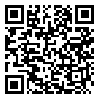Volume 12, Issue 49 (2015)
LIRE 2015, 12(49): 125-150 |
Back to browse issues page
Download citation:
BibTeX | RIS | EndNote | Medlars | ProCite | Reference Manager | RefWorks
Send citation to:



BibTeX | RIS | EndNote | Medlars | ProCite | Reference Manager | RefWorks
Send citation to:
Aspects of paradoxical styles in post-modern Farsi novels (Based on the works of Barahani, Ravanipour, Khosravi, and Kateb). LIRE 2015; 12 (49) :125-150
URL: http://lire.modares.ac.ir/article-41-1535-en.html
URL: http://lire.modares.ac.ir/article-41-1535-en.html
Abstract: (8150 Views)
Contradiction and overlap of alternative marks and concepts revolve round replacement of language. In any narration, whether it is descriptive or anecdotal, the narrator can choose one case from a number of marks to introduce the action or situation. That mark allows the said action or situation to be introduced with relatively precise and certain boundaries. Whenever the said boundaries lose their certainty due to overlap or interference of alternate marks, contradiction has occurred. Meanwhile, the level of similarity or difference of alternative marks is at times so stark or so minor, as if though there is no paradox. A variety of contradictions are evident in all literary forms. However, all-encompassing and large-scale contradictions are observed in some schools of thought or literary genres as the result of their ideological backbone or style. In post-modern literature, due to uncertainty in this genre, a variety of paradoxes are evident, and the ensuing obscurity baffles the reader. On this basis, from the two macro forms of apparent and connotative contradictions, the aspects of the latter type have been determined, classified, and analyzed within the works of four prominent authors based on the descriptive-analytical methodology. Based on results, contradictory characterization, overlap of the domains of tales and factual stories, and multilateral commitments, have been named as the main reasons behind the ambiguity of works.
Subject:
Contemporary Literature/ Story / Novel
Received: 2013/10/22 | Accepted: 2015/01/31 | Published: 2015/11/22
Received: 2013/10/22 | Accepted: 2015/01/31 | Published: 2015/11/22
| Rights and permissions | |
 |
This work is licensed under a Creative Commons Attribution-NonCommercial 4.0 International License. |






